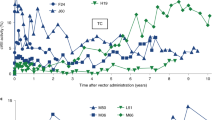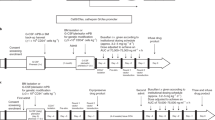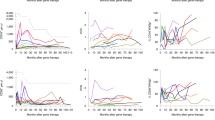Abstract
Recent successes in treating genetic immunodeficiencies have demonstrated the therapeutic potential of stem cell gene therapy1,2,3,4. However, the use of gammaretroviral vectors in these trials led to insertional activation of nearby oncogenes and leukemias in some study subjects, prompting studies of modified or alternative vector systems5. Here we describe the use of foamy virus vectors to treat canine leukocyte adhesion deficiency (CLAD). Four of five dogs with CLAD that received nonmyeloablative conditioning and infusion of autologous, CD34+ hematopoietic stem cells transduced by a foamy virus vector expressing canine CD18 had complete reversal of the CLAD phenotype, which was sustained more than 2 years after infusion. In vitro assays showed correction of the lymphocyte proliferation and neutrophil adhesion defects that characterize CLAD. There were no genotoxic complications, and integration site analysis showed polyclonality of transduced cells and a decreased risk of integration near oncogenes as compared to gammaretroviral vectors. These results represent the first successful use of a foamy virus vector to treat a genetic disease, to our knowledge, and suggest that foamy virus vectors will be effective in treating human hematopoietic diseases.
This is a preview of subscription content, access via your institution
Access options
Subscribe to this journal
Receive 12 print issues and online access
$209.00 per year
only $17.42 per issue
Buy this article
- Purchase on Springer Link
- Instant access to full article PDF
Prices may be subject to local taxes which are calculated during checkout




Similar content being viewed by others
References
Aiuti, A. et al. Correction of ADA-SCID by stem cell gene therapy combined with nonmyeloablative conditioning. Science 296, 2410–2413 (2002).
Gaspar, H.B. et al. Successful reconstitution of immunity in ADA-SCID by stem cell gene therapy following cessation of PEG-ADA and use of mild preconditioning. Mol. Ther. 14, 505–513 (2006).
Hacein-Bey-Abina, S. et al. Sustained correction of X-linked severe combined immunodeficiency by ex vivo gene therapy. N. Engl. J. Med. 346, 1185–1193 (2002).
Ott, M.G. et al. Correction of X-linked chronic granulomatous disease by gene therapy, augmented by insertional activation of MDS1-EVI1, PRDM16 or SETBP1. Nat. Med. 12, 401–409 (2006).
Hacein-Bey-Abina, S. et al. LMO2-associated clonal T cell proliferation in two patients after gene therapy for SCID-X1. Science 302, 415–419 (2003).
Russell, D.W. & Miller, A.D. Foamy virus vectors. J. Virol. 70, 217–222 (1996).
Trobridge, G., Josephson, N., Vassilopoulos, G., Mac, J. & Russell, D.W. Improved foamy virus vectors with minimal viral sequences. Mol. Ther. 6, 321–328 (2002).
Moebes, A. et al. Human foamy virus reverse transcription that occurs late in the viral replication cycle. J. Virol. 71, 7305–7311 (1997).
Yu, S.F., Sullivan, M.D. & Linial, M.L. Evidence that the human foamy virus genome is DNA. J. Virol. 73, 1565–1572 (1999).
Trobridge, G. & Russell, D.W. Cell cycle requirements for transduction by foamy virus vectors compared to those of oncovirus and lentivirus vectors. J. Virol. 78, 2327–2335 (2004).
Josephson, N.C. et al. Transduction of human NOD/SCID-repopulating cells with both lymphoid and myeloid potential by foamy virus vectors. Proc. Natl. Acad. Sci. USA 99, 8295–8300 (2002).
Leurs, C. et al. Comparison of three retroviral vector systems for transduction of nonobese diabetic/severe combined immunodeficiency mice repopulating human CD34+ cord blood cells. Hum. Gene Ther. 14, 509–519 (2003).
Vassilopoulos, G., Trobridge, G., Josephson, N.C. & Russell, D.W. Gene transfer into murine hematopoietic stem cells with helper-free foamy virus vectors. Blood 98, 604–609 (2001).
Falcone, V., Schweizer, M. & Neumann-Haefelin, D. Replication of primate foamy viruses in natural and experimental hosts. Curr. Top. Microbiol. Immunol. 277, 161–180 (2003).
Anderson, D.C. & Smith, C.W. Leukocyte adhesion deficiencies. in The Metabolic and Molecular Bases of Inherited Disease (eds. Scriver, C.R., Beaudet, A.L., Sly, W.S. & Valle, D.) 4829–4856 (McGraw-Hill, New York, 2001).
Hawley, R.G., Lieu, F.H., Fong, A.Z. & Hawley, T.S. Versatile retroviral vectors for potential use in gene therapy. Gene Ther. 1, 136–138 (1994).
Horn, P.A. et al. Efficient lentiviral gene transfer to canine repopulating cells using an overnight transduction protocol. Blood 103, 3710–3716 (2004).
Storb, R. et al. Stable mixed hematopoietic chimerism in dogs given donor antigen, CTLA4Ig, and 100 cGy total body irradiation before and pharmacologic immunosuppression after marrow transplant. Blood 94, 2523–2529 (1999).
Tone, Y. et al. Somatic revertant mosaicism in a patient with leukocyte adhesion deficiency type 1. Blood 109, 1182–1184 (2007).
Gu, Y.C. et al. Conversion of the severe to the moderate disease phenotype with donor leukocyte microchimerism in canine leukocyte adhesion deficiency. Bone Marrow Transplant. 37, 607–614 (2006).
Bauer, T.R., Jr. et al. Correction of the disease phenotype in canine leukocyte adhesion deficiency using ex vivo hematopoietic stem cell gene therapy. Blood 108, 3313–3320 (2006).
Beatty, P.G., Ledbetter, J.A., Martin, P.J., Price, T.H. & Hansen, J.A. Definition of a common leukocyte cell-surface antigen (Lp95–150) associated with diverse cell-mediated immune functions. J. Immunol. 131, 2913–2918 (1983).
Bauer, T.R., Jr. et al. Nonmyeloablative hematopoietic stem cell transplantation corrects the disease phenotype in the canine model of leukocyte adhesion deficiency. Exp. Hematol. 33, 706–712 (2005).
Trowald-Wigh, G., Ekman, S., Hansson, K., Hedhammar, Å. & Hård af Segerstad, C. Clinical, radiological and pathological features of 12 Irish setters with canine leucocyte adhesion deficiency. J. Small Anim. Pract. 41, 211–217 (2000).
Derse, D. et al. Human T-cell leukemia virus type 1 integration target sites in the human genome: comparison with those of other retroviruses. J. Virol. 81, 6731–6741 (2007).
Trobridge, G.D. & Russell, D.W. Helper-free foamy virus vectors. Hum. Gene Ther. 9, 2517–2525 (1998).
Creevy, K.E. et al. Canine leukocyte adhesion deficiency colony for investigation of novel hematopoietic therapies. Vet. Immunol. Immunopathol. 94, 11–22 (2003).
Bauer, T.R., Jr. et al. Very low levels of donor CD18+ neutrophils following allogeneic hematopoietic stem cell transplantation reverse the disease phenotype in canine leukocyte adhesion deficiency. Blood 103, 3582–3589 (2004).
Wu, X., Li, Y., Crise, B. & Burgess, S.M. Transcription start regions in the human genome are favored targets for MLV integration. Science 300, 1749–1751 (2003).
Hosack, D.A., Dennis, G., Jr., Sherman, B.T., Lane, H.C. & Lempicki, R.A. Identifying biological themes within lists of genes with EASE. Genome Biol. 4, R70 (2003).
Acknowledgements
We thank W. Telford and V. Kapoor for assistance with flow cytometry, A. Sowers for assistance with nonmyeloablative irradiation, J. Taylor for advice on quantitative PCR and X. Wu for assistance with insertion site analysis programs. This work was supported by the Intramural Research Program of the US National Institutes of Health, National Cancer Institute, and Center for Cancer Research and by US National Institutes of Health grant HL53750 to D.W.R.
Author information
Authors and Affiliations
Contributions
T.R.B. designed experiments, performed lymphocyte and neutrophil function assays, performed transductions, analyzed all data and wrote the manuscript. J.M.A. and E.M.O. prepared and characterized foamy virus vector stocks. M.H. performed LAM-PCR studies and LM-PCR studies and participated in the CD34 stem cell collection. L.M.T. collected and analyzed flow cytometry data, participated in CD34 stem cell collection and reinfusion, performed LM-PCR cloning and analysis and participated in clinical care of dogs. I.F.K. performed quantitative PCR. R.L.A. performed LAM-PCR and LM-PCR studies. T.H.B. was responsible for clinical care of dogs. Y.-c.G. participated in CD34 stem cell collection. D.W.R. designed experiments, supervised experimentation, coordinated the foamy virus vector production and wrote the manuscript. D.D.H. designed experiments, supervised experimentation, coordinated the project and wrote the manuscript.
Corresponding authors
Supplementary information
Supplementary Text and Figures
Supplementary Figs. 1–3, Supplementary Tables 1–4 and Supplementary Methods (PDF 3069 kb)
Rights and permissions
About this article
Cite this article
Bauer, T., Allen, J., Hai, M. et al. Successful treatment of canine leukocyte adhesion deficiency by foamy virus vectors. Nat Med 14, 93–97 (2008). https://doi.org/10.1038/nm1695
Received:
Accepted:
Published:
Issue Date:
DOI: https://doi.org/10.1038/nm1695
This article is cited by
-
Disease Presentation, Treatment Options, and Outcomes for Myeloid Immunodeficiencies
Current Allergy and Asthma Reports (2021)
-
Impact of gene therapy for canine monogenic diseases on the progress of preclinical studies
Journal of Applied Genetics (2020)
-
CRISPR-Cas9 fusion to dominant-negative 53BP1 enhances HDR and inhibits NHEJ specifically at Cas9 target sites
Nature Communications (2019)
-
Foamy virus zoonotic infections
Retrovirology (2017)
-
Evidence for the in vivo safety of insulated foamy viral vectors
Gene Therapy (2017)



